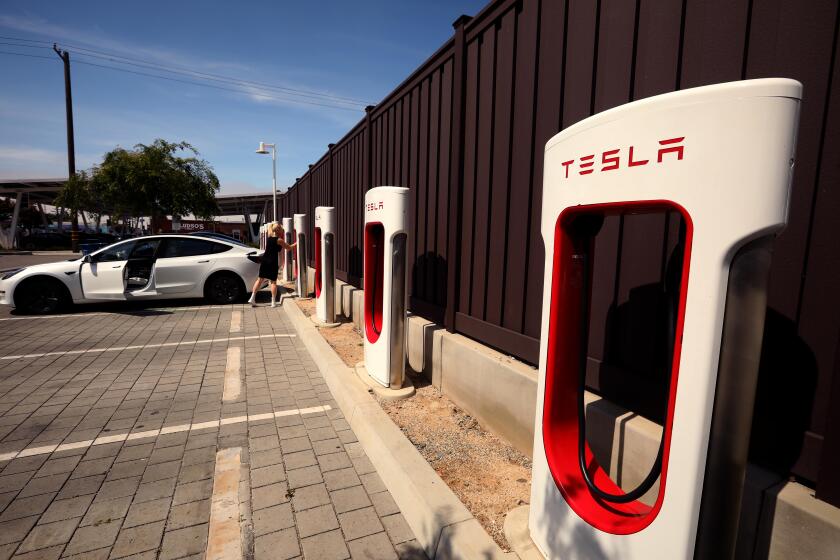At 24 Hours of Le Mans, life imitates TV
Relatively few Americans know what the 24 Hours of Le Mans is, so by way of introduction, I’d like to compare the event -- the 75th running of the storied motor race concluded Sunday with the seventh victory for Audi -- to something more familiar: Fox’s “24 Hours.”
OK, so Audi is Jack Bauer, and he’s trying to protect his country from the insurgents, who are, this year, the team from European powerhouse Peugeot. They, of course, are French. I don’t think I need to elaborate.
Jack Bauer uses the latest in technology to defeat the bad guys. Audi, too, uses the latest and coolest gear to win -- namely, diesel technology. This is the second year that Audi has raced and won the biggest event in motor sports using turbo-diesel engines of the future. But, just like, oh, every other episode of “24,” the bad guys have gotten hold of this key technology. So it was at Le Mans, when Peugeot -- led by open-wheel stars Sebastien Bourdais and Jacques Villeneuve (hiss, boo!) -- turned turbo-diesel technology against Audi. Behold, the evil-looking Peugeot 908 HDi Le Mans Prototype. Good Lord, what next, diesel-powered mimes?
For 23 of the 24 hours of Le Mans, it was a tense diesel standoff, the battle raging through rain and calamity. In order to hedge its bets, Audi added a car to its usual two-car complement but to no avail. One of the Audis crashed in Hour 4 of the race (the No. 4 car in the hands of the hapless, witless Mike Rockenfeller); while another, the No. 2 with multi-time winner Dindo Capello aboard, had a major shunt Sunday morning at the Indianapolis corner. Capello was not injured.
Meanwhile, the Peugeots proved to be more durable and wilier than expected, as insurgents often do. For a while, the fate of the free world -- or at least, the outcome of this progressively soggy endurance race with a record-breaking crowd of 250,920 watching -- hung in the balance. In the end, the surviving Audi stayed on pace, lapping the circuit comfortably in the 3-minute 27-second range, while the Peugeots fell behind in speed and reliability, unable to close the persistent five-lap deficit with the Audi. In the early afternoon, the No. 8 Peugeot succumbed to engine problems.
When a rain front moved over the track Sunday afternoon, race organizers brought out the safety car (the European version of the pace car), freezing the field and assuring Audi’s victory. The remaining No. 7 Peugeot had all the fight it wanted: “The end of the race was crazy with horrible conditions,” second-place finisher Bourdais said. “We had a big fright with the engine half an hour before the end.... I think it was designed to run for 24 hours and 10 minutes.”
Marco Werner, one of the co-pilots of the winning Audi team, described it this way: “It is the hardest, most dangerous and longest race in the world.
“I never expected when we were two laps behind at midnight to win the race.... The last stints were horrible, not car racing, more like boat racing. I was very angry that the pace car took so long to come out and then went in again.”
The highest-placing gas-powered team was Pesacarolo, which took third place for the third year in a row.
If Audi was glad to see the safety car, Aston Martin was ecstatic. The works team (which is to say, the factory-fielded cars, as compared to cars raced by privateers) had done everything in its power to give away its first win in the GT1 division, including a late-race agricultural excursion for the 007 car in the hands of Johnny Herbert that damaged the front of the car and required extensive repairs. The Aston’s sister car, the 009, eventually took over the lead in class and managed to fend off the rallying Corvette, driven in the final stint by team captain Ron Fellows. At the time the safety car came out, Fellows and the Corvette were gaining 20 seconds per lap on David Brabham in the 009 Aston.
“I was very aware that the win was in my hands and mine to lose as well,” Brabham said. “At the end, I could feel my arms and legs getting heavy with making sure we did not aquaplane and put it into the wall.”
By the numbers, this episode of Le Mans was not particularly casualty-filled, but in the smaller Prototype 2 class, it was a case of last man standing. Of 11 cars in LMP2, only two finished behind the safety car: the winning Binnie Motorsports Lola Zytek entry and the Barazi Epsilon Zytek factory team led by open-wheel star Adrian Fernandez, who pilots a Lowe’s-sponsored prototype in the American Le Mans series.
And so, like “24,” Le Mans ended with an emphasis -- some might say even paranoia -- on safety and security. Race scholars will long debate the deployment of the safety car. European road racing usually doesn’t stop for inclement weather, as compared with NASCAR, where they’ll throw a red flag if it’s sprinkling in the leader’s hometown. Without the safety car, things might have turned out very different. The Peugeot might not have even finished the race and Corvette might have yet another win over Aston.
And, after 23 hours of action, to watch the last hour unfold under the supervision of the safety car? It was just torture.



